“You’re wasting your time”, said Dick, “they never call during the day.” The road had been long, straight and snowy, and Mark had fallen asleep. When Dick spotted the Northern Hawk-Owl Surnia ulula perched in a tree on the other side of the field, everyone sprang into action. Mark pointed his parabolic dish despite Dick’s discouragement and an air temperature of -10°C. Perhaps through the sheer power of his will, the owl did call, and an obsession with hawk-owls was born.
The area around Yläne has a lot of forest, more than usual for south-western Finland. Fairly large patches of old growth remain but otherwise it is commercial, dotted with small farms and fields. The previous autumn a surplus of voles had attracted irruptive owls to settle in the area. At the end of winter the snow could have melted too quickly, causing the vole population to crash and the owls to move on. In March 2003, however, the blanket was still flawless and the owls were preparing to breed.
Towards the end of the next day, Dick and Killian dropped Mark off at the same spot. He rested his microphones on the snow, uncoiled 20 m of cables and stood at the far end. On his side of the road there was a ploughed field. On the other the forest blocked his view. For an hour, all remained silent and still. When a very distant hawk-owl finally became active at dusk, its voice emerged as if from nothing. Muted by snow and distance, it sounded like the whistle of an American freight train but diffuse, rising and rippling slightly. Mark was completely enthralled.
Moments later a rickety old tractor with snow chains rumbled into earshot. Punishing Mark slowly, it made its way along an invisible path through the trees directly behind him, then appeared on the road while the owl continued to hoot in the distance. The tractor stopped at the nearby farm. By now the temperature had dropped to -17°C, so when the driver got out he left the engine running and chatted to the farmer on his doorstep. Just when Mark’s nerve was beginning to crack, the noise stopped and something happened that thrilled him to the core. A second hawk-owl called in flight nearby. Settling a short distance behind him, much nearer than the first, it started to hoot in answer to the distant bird (CD1-73).
CD1-73: Northern Hawk-Owl Surnia ulula Yläne, Turku Pori, Finland, 9 March 2003. Hooting of two males, one near and one far. Background: farmers chatting. 03.006.MC.12430.11
The generic term ‘hooting’ describes the territorial and mate attraction signal of Northern Hawk-Owl less well than those of most other owls. Nevertheless, each rippling series is a string of tiny hoots, gradually rising in frequency over anything from 1 to c 30 seconds. They are delivered so quickly that I can only count them accurately with the help of sonagrams. Females occasionally hoot a similar song, especially when unpaired. According to Mebs & Scherzinger (2004) theirs is more variable in pitch and can sound a bit careless.
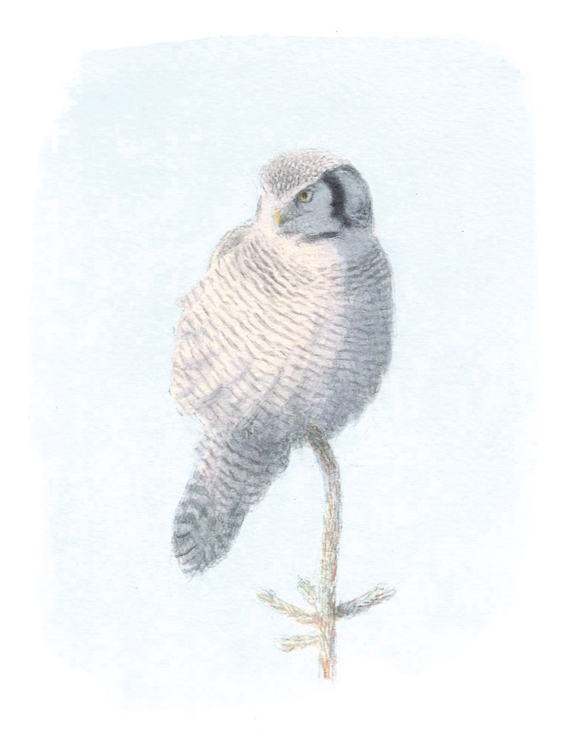
Håkan Delin
Despite being known as a diurnal species, hawk-owls generally hoot in the dark, especially near the start and end of the night. According to Finnish astronomer Harry Lehto their morning session usually begins at the start of nautical twilight, when the stars are still bright in the sky but you start to see the horizon clearly. Their hooting disappears with the stars, at the start of civil twilight.
In CD1-74, a male Northern Hawk-Owl is hooting in the broad daylight of a June morning. Dick recorded it at a typical breeding site in northern Finland, situated in sparse old forest on the edge of a huge clear-fell with some remaining woodlots and a few really old trees. When the weather is cold, northern Finnish forests like this sound dead, but with a rise in temperature everything bursts into song; the change is almost magical. This one is especially rich, and the nearby bogs host Spotted Redshank Tringa erythropus, Jack Snipe Lymnocryptes minimus and Broad-billed Sandpiper Calidris falcinellus. Just a few 100 m from the nest, a Brown Bear Ursus arctos wintered inside a huge anthill.
CD1-74: Northern Hawk-Owl Surnia ulula Kuusamo, Finland, 06:54, 8 June 2010. Hooting of a male. Background: Common Cuckoo Cuculus canorus, Eurasian Wryneck Jynx torquilla, Northern Raven Corvus corax, Bohemian Waxwing Bombycilla garrulus, Song Thrush Turdus philomelos, Common Redstart Phoenicurus phoenicurus, Brambling Fringilla montifringilla and Glip Crossbill Loxia curvirostra type C. 100608.DF.065440.01
Northern Hawk-Owls usually breed in vast stretches of forest interspersed with open areas. Nowadays, most pairs breed on or beside large clear-fells, often with remnant stands of older trees. Open areas provide food while older trees provide nests. Since they can move easily even through rather dense vegetation, they can also breed deep in the forest where we are less likely to find them. They only stop to breed in areas with a very high density of voles. If there is food they will somehow find a suitable nest, which may be in a hollow stump, or in a hole excavated by a Black Woodpecker Dryocopus martius. In the far north where there are only stunted birches, they even breed in old nests of Hooded Crows Corvus cornix.
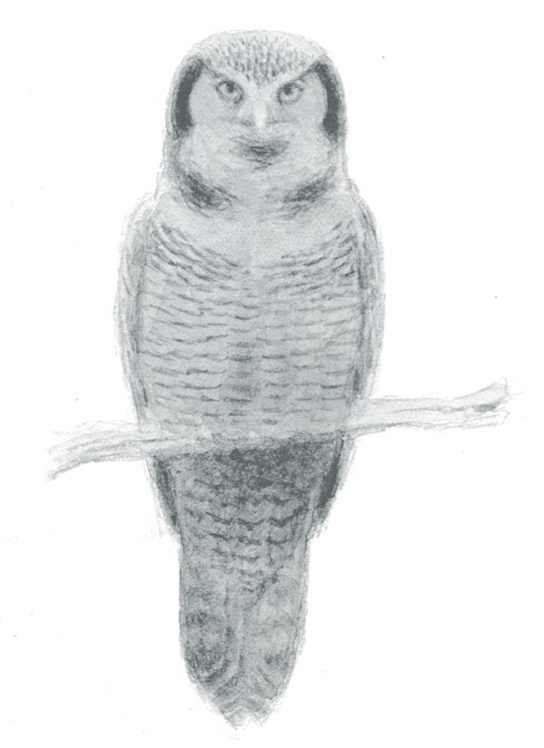
Håkan Delin
Long series of hoots at a medium, slowly rising pitch propagate well in the relatively sparse taiga. Any creature listening can judge distance from the degree of blurring by echoes from trees. Other kinds of hooting might have worked just as well, but ‘microhooting’ was still available in the vast taiga forests of the far north when the Northern Hawk-Owl appeared on the scene. There is nothing else that sounds quite like one throughout its vast Palearctic breeding range.
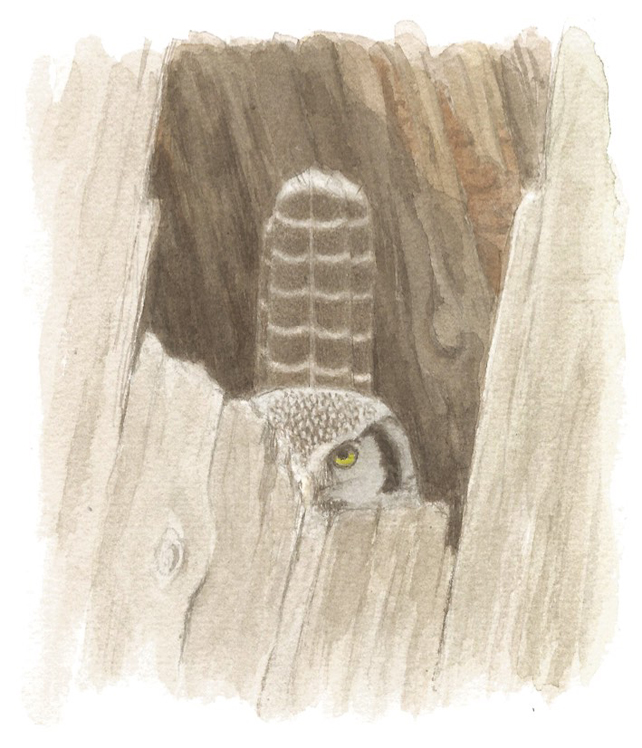
Håkan Delin
In Alaska and Canada, darker-faced and broader-barred subspecies caparoch does sound very subtly different (CD1-75). I learned this by comparing 10 caparoch with 11 Eurasian ulula (up to three series each). On average, caparoch hoots 12.6% more slowly and rises more steeply to a higher maximum pitch. There is also a difference in the shape of the individual hoots. It is conceivable that caparoch may have evolved a slower but more strongly rising song to differentiate itself from Eastern Screech Owl Megascops asio, which has a faster rippling song on an even pitch. Although their ranges do not overlap today, caparoch occurred at least as far south as Tennessee, USA, during the Late Pleistocene (Parmalee & Klippel 1982).
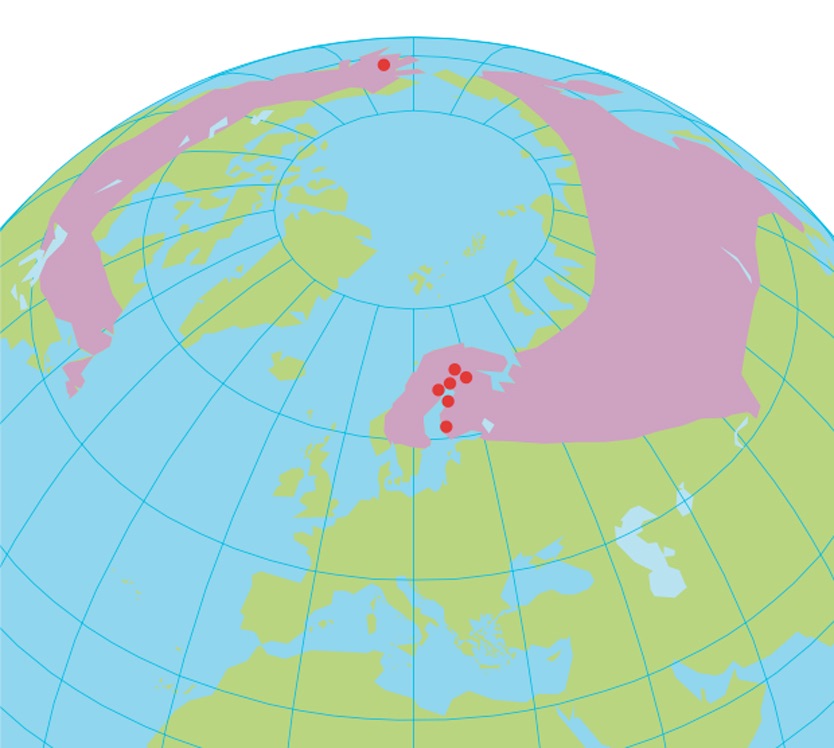
Approximate breeding distribution of Northern Hawk-Owl Surnia ulula . Recording locations indicated by red dots.
CD1-75: American Hawk-Owl Surnia ulula caparoch Nelson’s Clearwater, Fairbanks, Alaska, USA, 15:00, 27 June 1972. Hooting of a male in response to playback. Background: Olive-sided Flycatcher Contopus cooperi, Tree Swallow Tachycineta bicolor, Swainson’s Thrush Catharus ustulatus, Dark-eyed Junco Junco hyemalis, American Yellow Warbler Setophaga aestiva and Myrtle Warbler S coronata. Leonard J Peyton and The Macaulay Library at the Cornell Lab of Ornithology.
So far, nobody has published a DNA comparison of ulula and caparoch, so we do not know how long they have been evolving separately. Ecologically, caparoch is much less dependent on voles. When the 10-year cycle in the population of the Snowshoe Hare Lepus americanus is at its peak, young hares form 40-50% of caparoch’s diet (Rohner et al 1995).
Courtship plays out in a brief whirlwind of threats, chases and tenderness. In fading light or darkness it is often difficult to tell the sexes apart, but the tension between them is obvious. In CD1-76, a perched male gives a long series of kirrirritt calls, which Håkan describes as “like a mean, sharp-voiced, giant Crested Tit”. He continues to call kirrirritt as he flies across to the female perched nearby. She responds with a smoother version of the same call which melts into an ecstatic, lower-pitched croon. Håkan has also heard the kirrirritt call in winter. He had been watching a hawk-owl that seemed to be perched happily on the top of a dead tree when suddenly it flew some 200 m at high speed and with forced wingbeats. It gave a loud kirrirritt as it shaved the crown of a Ural Owl Strix uralensis perched at the edge of the forest. The Ural seemed almost completely indifferent.
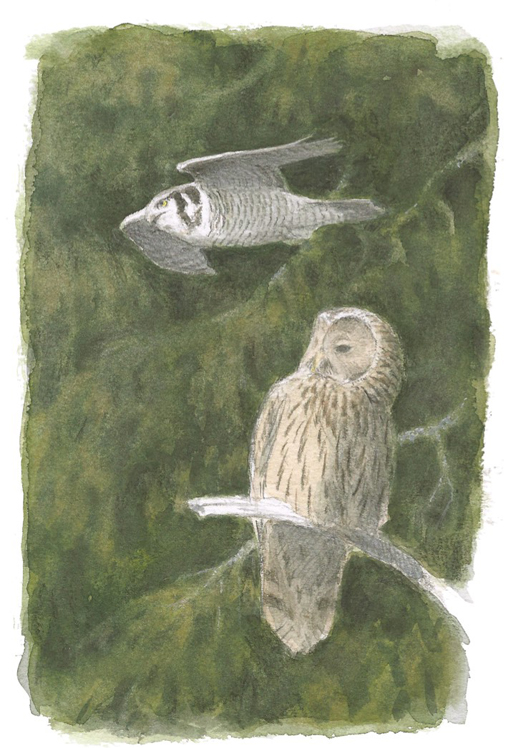
Håkan Delin
CD1-76: Northern Hawk-Owl Surnia ulula Raahe, Ostrobothnia, Finland, 18:15, 11 March 2003. Kirrirritt calls of a presumed male flying towards a female, followed by her ecstatic-sounding response. 03.002.KM.00057.11
On another occasion, Håkan was owling at midnight. A female Northern Hawk-Owl had been begging persistently, and he could see her bowing forward against the full moon. Copulation seemed imminent. Her mate was hooting, but not the usual long series with 15-20 second gaps between them. Instead he gave short series that followed one another closely, forming an intense duet with the female’s kshyyyy-lip calls. Suddenly he shifted to a distinctive, quite different sound. The familiar ripple was interrupted about twice a second by lower-pitched notes that sounded like inhalations.
In the struggle to find a name for this call, I have borrowed one from studies of chimpanzees. Let’s call it ‘pant-hooting’. The Sound Approach has never been lucky enough to record pant-hooting, but CD1-77 is a recording by Ove Stefansson of a pair that he observed mating. After one of the birds pant-hoots, the other bird gives a series of very high-pitched squeals. This must be Northern Hawk-Owl’s copulation call.
CD1-77: Northern Hawk-Owl Surnia ulula Brännberg, Norrbotten, Sweden, 30 March 2007.
A pair copulating: first ‘pant-hooting’ and then copulation calls. Ove Stefansson.
The soliciting call is a kshyyyy-lip that sounds surprisingly similar to the perennial screech of a barn owl Tyto. Most commonly it accompanies soliciting behaviour of females, either for food or copulation. The male also sometimes calls kshyyyy-lip when he brings food to the nest. Later in the breeding cycle it may be used in more stressful situations. We have twice recorded kshyyyy-lip from nervous hawk-owls with young as they confronted us in the heart of their territory. CD1-78 was recorded near a nestbox in northern Finland that contained fairly small-sounding young.
CD1-78: Northern Hawk-Owl Surnia ulula Haapalahti, Lapland, Finland, 15:30, 5 June 2003. Loud kshyyy-lip calls of a presumed female near a nestbox. Background: Wood Sandpiper Tringa glareola, Common Snipe Gallinago gallinago, Willow Warbler Phylloscopus trochilus, Pied Flycatcher Ficedula hypoleuca, Redwing Turdus iliacus and Common Redstart Phoenicurus phoenicurus. 03.007.KM.10154.01
Young Northern Hawk-Owls have a begging call very similar to the adult kshyyyy-lip but weaker and higher-pitched. In CD1-79, there were five young, and they had moved 100 m from the nest since fledging. The young also have a chitter call that they use to express discomfort. It is so quiet that it seems unlikely to attract much attention from a distance. Killian was very close to the nestbox and using a directional microphone when he recorded CD1-80.
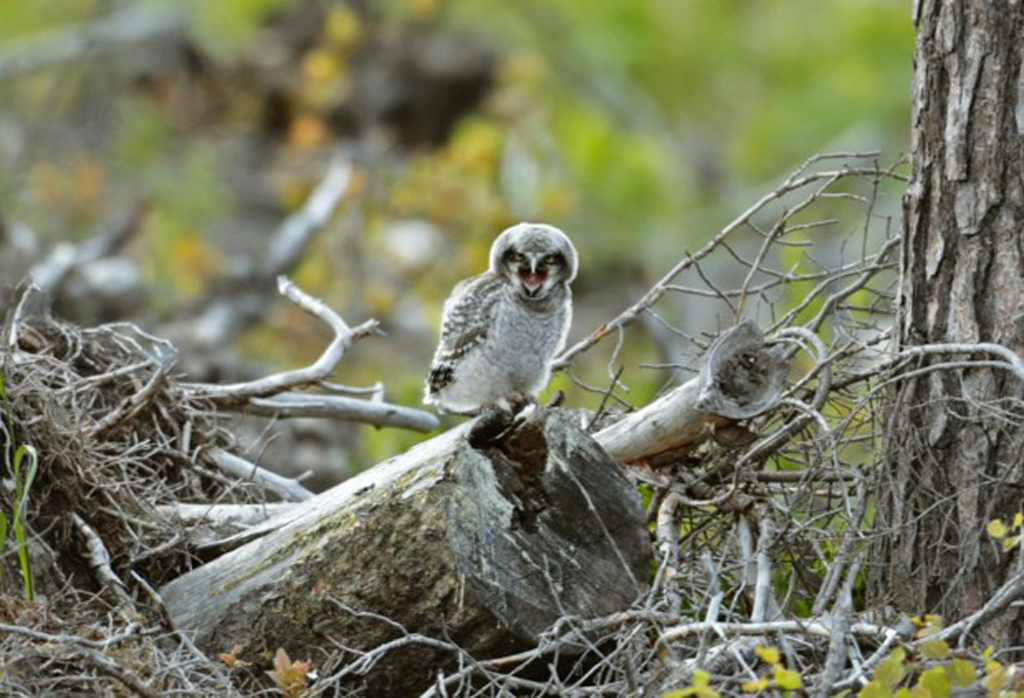
Northern Hawk-Owl Surnia ulula, fledgling, Keminmaa, Lapland, Finland, 5 June 2010 (Dick Forsman). Out of nest only for c two days and c 100 m from nest. Same as in CD1-79 & 82.
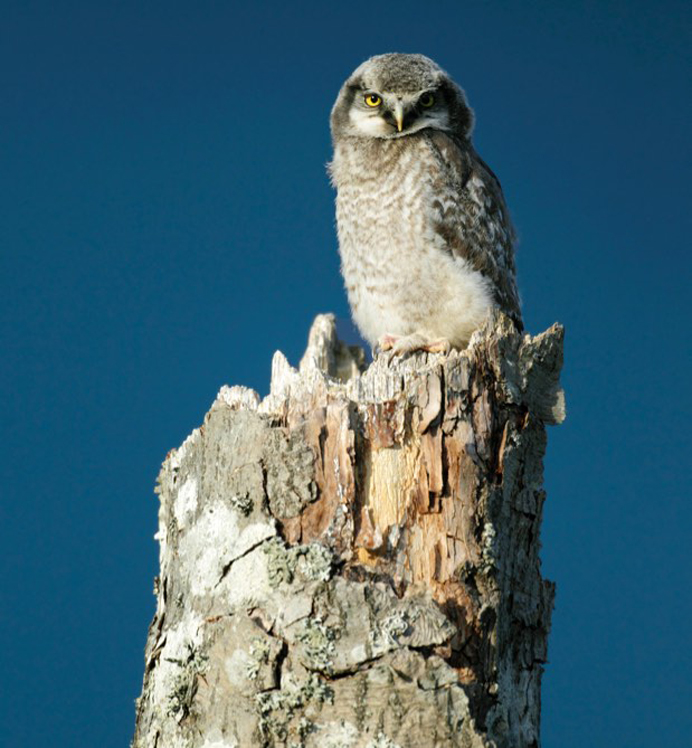
Northern Hawk-Owl Surnia ulula, fledgling, Keminmaa, Finland, 5 June 2010 (Dick Forsman). Same as in CD1-79 & 82.
CD1-79: Northern Hawk-Owl Surnia ulula Tornio, Lapland, Finland, 19:44, 5 June 2010. Begging calls of fledged young. Background: Willow Warbler Phylloscopus trochilus. 100605.DF.194406.0
CD1-80: Northern Hawk-Owl Surnia ulula Haapalahti, Lapland, Finland, 16:25, 5 June 2003. Very quiet chitter call of nestling. Background: Redwing Turdus iliacus and Brambling Fringilla montifringilla. 03.007.KM.12100.01
Northern Hawk-Owls are powerful, aggressive creatures, and they often attack larger owls and raptors. They may also attack people when their young seem threatened, making really nasty attacks. Mark was oblivious to the danger when he recorded CD1-81. The excitement call, a persistent vit–vit– vit, often precedes attack as indeed it did on this occasion.
In CD1-82, Dick is the one risking life and limb. Several young are begging while the distant, left of centre male calls vit–vit–vit and the closer female calls both vit–vit–vit and kshyyyy-lip, fuller and lower-pitched than the young.
CD1-81: Northern Hawk-Owl Surnia ulula Haapalahti, Lapland, Finland, 5 June 2003. Vit- vit-vit calls of an adult near a nestbox with young. Background: Common Snipe Gallinago gallinago, Willow Warbler Phylloscopus trochilus and Pied Flycatcher Ficedula hypoleuca. 03.021.MC.03130.01
CD1-82: Northern Hawk-Owl Surnia ulula Tornio, Lapland, Finland, 19:44, 5 June 2010. Vit- vit-vit calls of male (more distant) and female (closer) with begging calls of young. Background: Willow Warbler Phylloscopus trochilus. 100605.DF.194406.01
The classic winter view of a hawk-owl is of one perched silently, turning its head quickly now and then, without warning. When it flies, you might hear its fast, purposeful wingbeats. When it perches again, all you hear is its powerful aura. On two days in April 2012, a pair of Parrot Crossbills Loxia pytyopsittacus mobbed a hawk-owl that Håkan and I were watching on the edge of a clearing (CD1-83). Surveying the scene silently from its favourite dead pine, it seemed interested in everything but them.
CD1-83: Parrot Crossbills Loxia pytyopsittacus Västerås, Västmanland, Sweden, 15:55, 18 April 2012. Excitement calls of a pair mobbing a Northern Hawk-Owl Surnia ulula. Background: Song Thrush Turdus philomelos and Common Chaffinch Fringilla coelebs. 120418.MR.155526.01
Håkan once saw a hawk-owl terrifying a Hooded Crow with a mere glance of its stern, yellow eyes. The owl was perched on a telephone wire when the crow landed a couple of metres away. It jumped nearer and nearer but the owl took no notice. When it was just 30 cm away, the owl made a sudden turn of its head and the crow just catapulted away.
A hawk-owl’s eyes are powerful weapons indeed. By contrast, its sound-gathering facial disk is poorly developed, and its head appears small for an owl. Hawk-owls rely primarily on vision rather than hearing to detect their prey, as suggested by their diurnal habits and noisy flight. When the ground is covered by snow, they give up on their preferred diet of Field Voles Microtus agrestis and Root Voles M oeconomus, which live in clear-fells. Instead they turn to smaller Bank Voles Myodes glareolus living in mature forest (Nybo & Sonerud 1990). Field and Root Voles move underneath the snow, whereas Bank Voles often move on the surface where they are easier to detect.
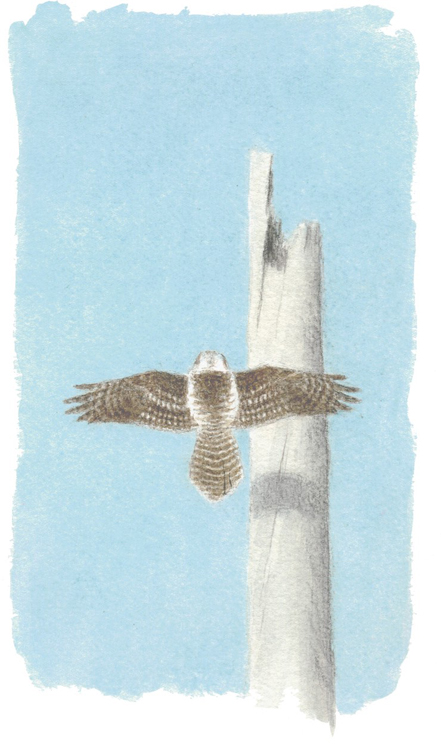
Håkan Delin
Unlike Tengmalm’s Owls Aegolius funereus, hawk-owls of both sexes leave when the vole population crashes, only to return when numbers are approaching peak levels again two years later. This means that they are absent for at least half of each four-year vole cycle (Sonerud 1994). There are no records of either sex staying in an area through the worst of a vole cycle (Sonerud 1997). Most movements take place in autumn and spring. Adult males and juvenile females usually winter within the breeding range, where males claim the best breeding territories as early as possible. Adult females and to a lesser extent juvenile males compete for the best winter territories in lowlands where they have a wider variety of prey and less snow to contend with (Byrjedal & Langhelle 1986).
Northern Hawk-Owls are highly nomadic and may wander great distances in search of voles. Two Finnish juveniles were recovered east of the Urals, 2795 and 2659 km from where they had been ringed. Three turned up 1200-1400 km away in southern Norway (Saurola 2002). American Hawk-Owls have even been known to cross the Atlantic, one being captured alive on board a collier off Cornwall in March 1830, and another flying onto a ship off Las Palmas in the Canary Islands in 1924 (Harrop 2010, Rosmay & Roselaar 2013).
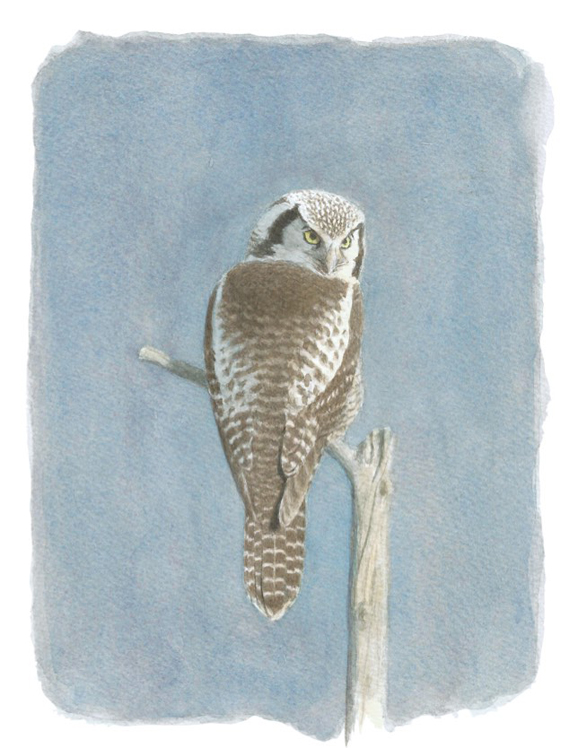
Håkan Delin
Vagrants from northern Eurasia have thrilled many birders in recent years, although hawk-owls hardly require the element of surprise to turn them into dream birds. Personally, I prefer to see them in the vast taiga of the far north, exactly where they belong. Their closest Palearctic relative is a tiny twitcher that prefers not to see hawk-owls at all. Although it thinks nothing of adding the odd ‘mega’ to its larder, it all too often ends up as owl fodder itself.
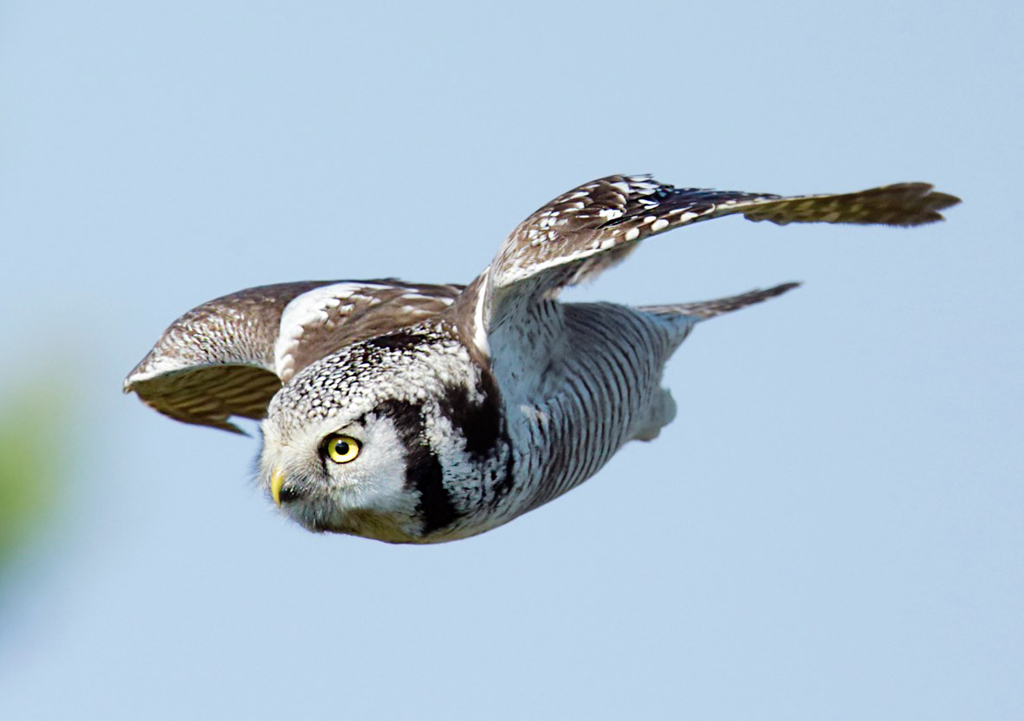
Northern Hawk-Owl Surnia ulula, juvenile/first-winter, Hanko, Uusimaa, Finland, 13 September 2013 (Dick Forsman)
